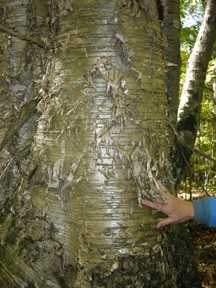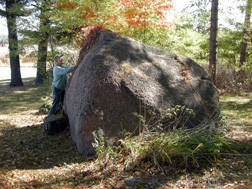Scenic and Geologic Wonders of North-central Wisconsin
- Share
- Tweet
- Pin
- Share

Huge granite boulders strewn along the riverbed at Big Falls County Park are admired by Roy & Charlotte Lukes.
A year ago Charlotte and I agreed to do our program, “Wings Over Door County” in late September for the Chequamegon Bird Club of Medford in Taylor County, never dreaming that our three-day trip would turn out to be so wonderfully exciting and educational. Our good friend, Ron Shiffler, veterinarian in Medford and student of many of our Björklunden classes in Baileys Harbor over the past 15 years, organized the event, and we stayed with him. Ron is a great student of natural history, and he introduced us to some of the finest and most fascinating of the scenic and geologic wonders.
Perhaps a part of my deep interest in geology and rocks stems from my mother’s maiden name, Skala, which in the Czech language means rock. Our first stop was at the Big Falls County Park in southwest Price County, north of Taylor County. Here the glacier left an awesome record of its power where the melt-water wore a deep riverbed through the igneous granite rock and, in so doing, broke off millions of tons of large granite boulders now strewn in the riverbed and adjacent areas. The important CCC program, initiated by President FDR back in the 1930s, did much of the work to make this excellent park so available and useful to area people.
The three-mile-long Mondeaux Flowage in the Chequamegon-Nicolet National Forest is a “must see” visit for anyone interested in Wisconsin’s glacial geology. Here the 1.2-mile Aldo Leopold Commemorative Trail follows, in part, the 200 to 300-foot-high crest of the great Mondeaux Esker, the rock-strewn riverbed that wore its way through the glacial ice. When the glacier melted, the very steep, rocky, riverbed simply settled downward to rest on the bedrock of that area.
The trail is dedicated to the memory of Aldo Leopold and his conservation ethics. The reflective quotes along the way include, for example: “We abuse land because we see it as a commodity belonging to us. When we see land as a community to which we belong, we may begin to use it with love and respect.” All of Leopold’s quotes along the trail are from his book A Sand County Almanac, which provides insight into our relationship with the land.
Some of the largest and most splendid Yellow Birches we have ever seen grow along the Leopold Trail, which winds through this somewhat different mixed northern hardwoods forest containing predominantly Sugar Maples, Red Maples, Yellow Birches and Eastern Hemlocks. Here, as well in the wooded areas of Taylor and Price counties, the fall color changes were as beautiful as one could imagine. Another exciting highlight of our hike with Ron along the Mondeaux Flowage was seeing a pair of Trumpeter Swans.

Giant Yellow Birches grow along the Mondeaux Esker in the Chequamegon-Nicolet National Forest.
Visiting Wisconsin’s Rustic Road Number One was our next exciting adventure. With its dedication September 27, 1975, this narrow graveled road, having nearly a continuous five-mile-long canopy of trees above the route, became one of the first roads in the nation to be preserved for its rustic and scenic characteristics. This road was intended by the Rustic Roads Board to be the first of a statewide network of Rustic Roads maintained for “unhurried, quiet, and leisurely enjoyment.” Yes, it was precisely that!
What great vision a group of forestry people had when they layed out an educational hiking route though the Gerstberger Pines area two miles southeast of the town of Rib Lake. Here, with the nucleus and highlight of the wooded area being several huge White Pines, one can use an informational booklet to learn and observe a great deal about the natural succession, from tree seedling to death, of both evergreen and deciduous trees. How I wish every county in Wisconsin would have such an outstanding, self-guided, free, forestry trail.
Our bird program Monday evening with the Chequamegon Bird Club proved to be a real eye-opener for Charlotte and me. What an outstanding group of people this is, working constantly to learn more about birds, to conduct the annual Christmas Bird Count, and especially to bring more bird and natural history learning into area schools.
We had the great pleasure to meet and chat with several of the club members. Two sisters, Hildegard and Loretta Kuse, retired educators, are working hard to use some of the modern technology, such as iPods, to help students get turned on to the natural world, learn more about it and respect it. These ladies have a website that many educators will be interested in studying: http://kuse.medford.k12.wi.us/main/index.html.
We prefer, as often as we can, to include plenty of side roads when we travel. Much of our trip home Tuesday morning, Sept. 25, took us not only through some great tree color and rolling countryside west of Wausau and Rib Mountain but also past some fascinating geographical and geological points of interest.

Huge, glacially deposited boulders adorn the grounds of the Peace Lutheran Church in Tilleda, Wisconsin.
It was southeast of the city of Medford that our friend Ron told us to visit an important geographical marker situated along a very quiet graveled country road. It reads: “This spot in Section 14, in the town of Rietbrock, Marathon County, is the exact center of the northern half of the Western Hemisphere. It is here that the 90th Meridian of Longitude bisects the 45th Parallel of Latitude, meaning it is exactly halfway between the North Pole and the Equator, and is a quarter of the way around the Earth from Greenwich, England.”
What interested us as we read the historic sign was knowing that not too many miles directly east of where we stood lies Meridian Park in Door County, the wayside midway between Baileys Harbor and Jacksonport. Here a bronze plaque does indicate the geographical significance of the park. However, those responsible for naming it got the terms “meridian” and “parallel” mixed up. Yes, the park is at the 45th Parallel, not the 45th Meridian! Surely some purists might insist that the park’s name be changed to “Parallel Park!”
Our last major stop before heading home was a site we’ve visited and enjoyed several times in the past, the small community of Tilleda located on highway “D” north of State Highway 29. Here the Peace Lutheran Church and parsonage/office are virtually surrounded by incredibly large and beautiful granite boulders, most adorned by growths of lichens and even a few with small trees growing from fissures in the boulders.
Boulder trains, enormous concentrations of igneous boulders ranging from small to gigantic and literally “dumped” by the melting of the glacier, have always fascinated me. The Tilleda Boulder Train brought our three-day, adventure-loaded vacation to a close, reminding us with clarity of what a truly great state Wisconsin is to live, learn and enjoy life.


